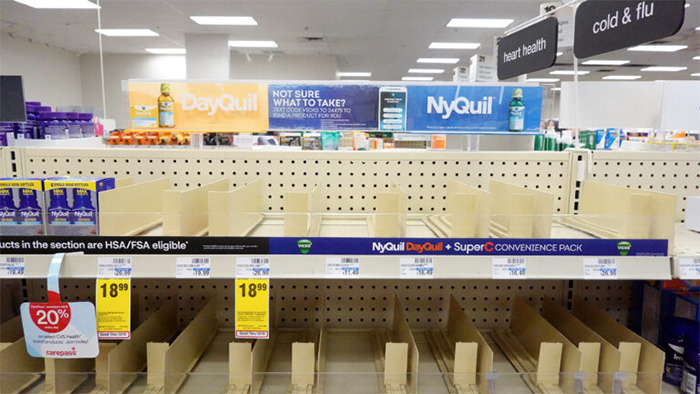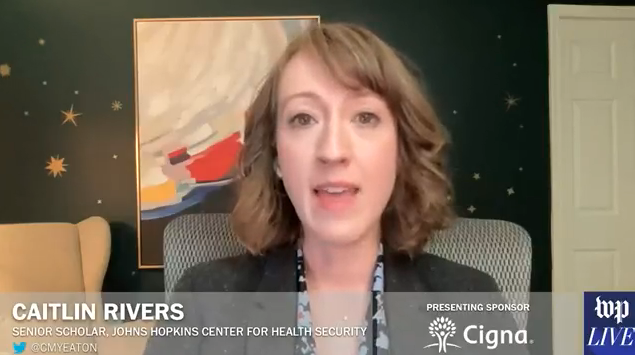One of the primary ways that we think about risk communication comes from a CDC handbook on risk communication, “Be first, be right, be credible.” And I think we need to return to our roots in trying to achieve be first, be right, be credible. And I think by continuing to show up and do that well, that is the way that we will build back that trust. But I don’t expect it to happen overnight. I think that we really need to be in it for the long haul.
MS. WINFIELD CUNNINGHAM: And I know we briefly mentioned kids, but let’s return to that topic, because it’s one I know that I wrote a lot about during the pandemic, and that was the approach to schools and the closures. And I know recently, we have seen very troubling test scores. Now granted, it looks like test scores are kind of poor across the board, even in states that tended to keep schools open more than other states. But what’s your–what’s your overall take on where we’re at with kids and education, and did we learn any lessons?
DR. RIVERS: I’m concerned about this as well. Again, I am a parent, and my children were home for a long time during the pandemic. And I think that it does need to be a shared national commitment not only to keep kids in school, but to keep them safe in school. And that was always my policy stance, if you will, around education, that schools are not inherently safe against viral transmission, but they can be made safe. I think earlier in the pandemic, masking was an important strategy. Even now, ventilation and filtration are important strategies. And that is true not just of covid-19 but also the RSV and influenza that we are seeing right now.
But it’s not just about public health. Schools are for education. That is their purpose. And I never saw the energy around catching kids up that I saw early in the pandemic when school closures were prevalent. There were a lot of discussions about summer school and tutoring and what are the strategies that we can use to reach kids who have fallen behind, and I’m not sure we’ve really stayed in touch with that enthusiasm. And so that’s something that I would like to see us return to.
MS. WINFIELD CUNNINGHAM: So, the threat now of RSV and the flu, I’m remembering I think two weeks ago, my middle child, half of his class was actually gone, out sick. So, this is definitely going around. Can you talk to us about how serious those threats are this year?
DR. RIVERS: I’ve been seeing that in my area as well, and it is a very widespread problem. The virus that’s circulating the most right now from what I’ve seen is RSV, or respiratory syncytial virus. This is a virus that is very common and spreads very easily both through the air and through contaminated surfaces. For most older children, for working age adults, it causes a cold. But for young babies and for older adults, it can be very serious. In fact, hospitalizations for RSV right now are the highest we’ve seen in years for children under the age of one year old. And so if you have cold-like symptoms, even if they’re not a big deal to you, I really encourage you to stay home when you can and wear a mask if you have to go out, because it’s those young babies that we’re thinking about.
Looking ahead a little bit, we’re already off to quite a severe flu season. We’re about two months ahead of schedule. And the level of flu activity that we’re seeing right now is more on par with what we would normally see in January. So, if you haven’t gotten your flu shot, I encourage you to do that. And again, think of these strategies that we used during covid-19 to reduce transmission and bring those into this next flu season. As a working parent, I know how disruptive it is to be home with your kids all the time when they’re not feeling well, and I know that I’m going to do what I can to avoid that.
MS. WINFIELD CUNNINGHAM: Do we have a sense yet of who is most at risk from the flu this year, and also how effective this year’s flu shot is? I know that it does vary from year to year because it’s sort of a guessing game as to how to formulate it.
DR. RIVERS: That’s right. Young children and older adults–this is common across infections–are at the highest risk of severe illness. But really anyone can get severely ill with influenza, and that’s why it’s important to get vaccinated every year. We don’t yet have a sense of how good this year’s vaccine matches up with what’s circulating. But based on what I’m seeing so far in the data, I feel pretty good about it. Again, we won’t know really until January. But the two strains that are most common right now are H3N2 and H1N1, and both of those are in this year’s formulation. And so I am hopeful that it will be a good match.
DR. RIVERS: And before we leave the topic of covid entirely for this interview, I did want to ask you about an investigation that recently was released by Senate Republicans, and it concluded that the pandemic was, quote, “More likely than not the results of a research-related incident.” What do you make of that finding?
DR. RIVERS: Well, I think this is a really difficult area that from my perspective will never be settled to the highest evidentiary standard. I don’t think we will ever truly know from where the pandemic originated. I think it was most likely originating in animals because most new infectious diseases are. But again, I’m not sure that we’ll ever get that final say. But I think it’s enough to recognize that it is a possibility maybe that that labs can be sources of leaks, of accidents, of spillover events. And I think that–just that observation enough to know that it’s possible is reason to continue to focus on lab safety and lab biosecurity as important strategies for reducing our overall risk.
MS. WINFIELD CUNNINGHAM: Let’s talk about a little bit of good news for a minute. Over the summer, there were a lot of kind of scary headlines about monkey pox and the threat of that, but now it appears the spread has significantly slowed down. What happened there?
DR. RIVERS: This is a good news story for public health. Monkey pox is a very uncommon virus that spreads right now–during this epidemic–spreads primarily between men who have sex with men. Over the height of the summer in August, there were about 450 new cases every day, and there are now only about 25 new cases every day. And so there’s been dramatic improvement over the course of that epidemic.
I think we can attribute a handful of things. It’s an all of the above situation. But certainly, education and behavior change in the affected community, vaccination and outreach and contact tracing by public health officials I think have all contributed to what we’re seeing is a rapidly declining outbreak.
MS. WINFIELD CUNNINGHAM: I know that you were recently part of an initiative at the CDC that was trying to forecast how bad the next virus outbreak could be and offer some policy solutions to that. And you likened the effort to the National Weather Service. Can you explain a little bit how that worked?
DR. RIVERS: Yes, the Center for Forecasting and Outbreak Analytics is the newest Center at CDC. It was founded–we opened our doors, if you will, earlier this year, and its purpose is to bring forecasting and outbreak analytics to public health problems where decision makers are having to make decisions very quickly. And in the past, they haven’t always had the data or analyses that they need in order to make those decisions in an informed matter–manner rather. And so the purpose of CFA, the Center for Forecasting and Outbreak Analytics, is to bring together the best modelers, the best data scientists, epidemiologists, and really create an engine to produce those analyses to support decision making.
The center is just in the hiring stage right now, getting their feet under them. You can see a few of their early successes at cdc.gov/cfa. But I think this effort will really grow into be–into one of the core capacities that we use to respond to outbreaks in the United States.
MS. WINFIELD CUNNINGHAM: So, what’s on your radar right now? What are you watching out for in the future, and what should Americans be watching out for?
DR. RIVERS: In addition to influenza and RSV, which are two viruses that are close to home and are causing quite a stir this year, I have my eyes on an outbreak of Ebola Virus Disease in Uganda. This outbreak of Ebola is caused by Sudan virus, and I note that because it’s a different virus than what had caused outbreaks in the DRC and in West Africa in previous years. That’s important because none of the vaccines or the treatments that were developed for those other strains work on this strain. And so Ugandan officials are really having to rely on traditional and core public health strategies of contact tracing, isolation, and quarantine to break chains of transmission. And it’s been a bit of a struggle. It’s been a difficult outbreak to really get their arms around, and so I have my eye on that closely.
MS. WINFIELD CUNNINGHAM: Well, unfortunately, we’re out of time, so we’ll have to leave it there. But, Dr. Rivers, thank you so much for joining us today. It was a fascinating conversation.







